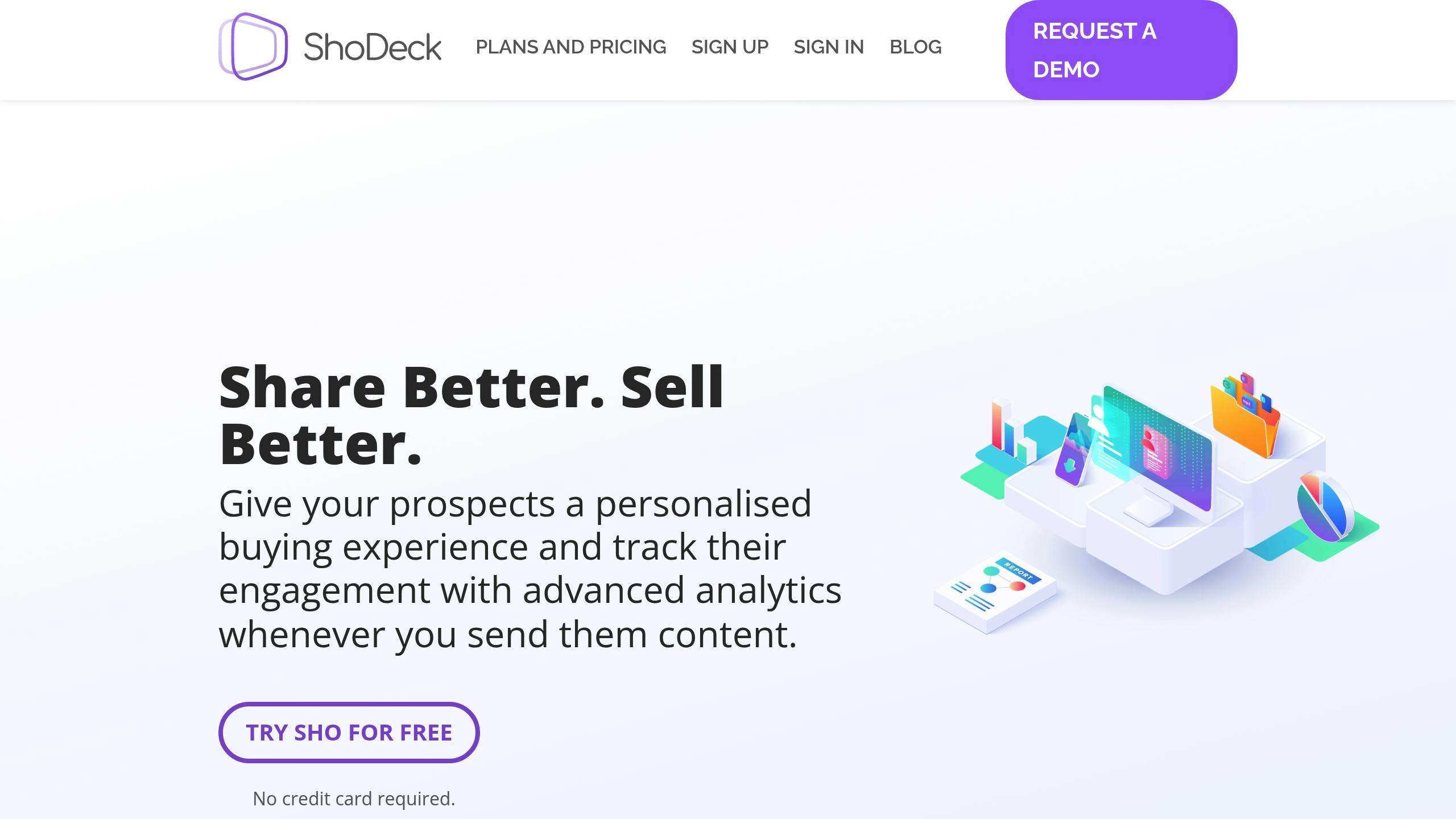Tracking buyer engagement in B2B sales can help you generate 50% more sales-ready leads and cut costs by 33%. With 68% of buyers researching independently before contacting sales, it’s essential to monitor their behavior using modern tools and metrics. Here’s what you need to know:
- Key Metrics: Track how prospects interact with your content (e.g., view duration, email open rates) and CRM data (e.g., deal velocity, stakeholder count).
- Tools: Use CRMs like Salesforce or HubSpot, content sharing platforms, and email analytics tools like Yesware.
- Benefits: Improve conversion rates by 22%, shorten sales cycles by 20%, and prioritize high-value leads.
Essential B2B Buyer Engagement Metrics
Document and Content Analytics
Did you know that prospects who spend more than 50 seconds on a sales deck are three times more likely to respond to follow-ups? [1] That’s why tracking how your content performs is so important.
| Metric | What It Tells You |
|---|---|
| View Duration | How deeply prospects engage |
| Scroll Depth | Whether the content resonates |
| Return Visits | If they’re seriously considering |
| Sharing Rate | Interest across stakeholders |
Email Performance Metrics
On average, B2B emails see 21.3% open rates and 3.2% click-through rates [6]. But what do these numbers actually mean for engagement?
| Metric | What It Shows |
|---|---|
| Open Rate | How much initial interest exists |
| Click-Through Rate | Whether the content connects |
| Reply Rate | Level of active engagement |
| Forward Rate | If it’s being shared internally |
CRM Data Points
According to Salesforce, deals involving multiple stakeholders are 90% more likely to close [3]. Meanwhile, HubSpot found that faster-moving deals are 28% more likely to succeed [4]. These insights show just how critical CRM metrics are for predicting outcomes.
| Metric | What It Means |
|---|---|
| Deal Velocity | Speed through the pipeline → Indicates momentum |
| Meeting Frequency | How often you interact → Highlights engagement |
| Stakeholder Count | Number of decision-makers → Helps predict success |
| Response Time | How quickly they reply → Shows urgency and priority |
"High-performing sales teams are 2.8 times more likely to use integrated data from multiple sources for lead prioritization" – Salesforce State of Sales Report [8]
These metrics give you a clear view of buyer behavior and help shape the tools you’ll need next.
Best Software for B2B Engagement Tracking
CRM Systems
CRM platforms are essential for tracking and managing engagement. Did you know that 91% of companies with more than 11 employees rely on CRM software? On average, these businesses experience a 29% boost in sales[1].
| CRM Platform | Ideal For | Key Engagement Features | Price Range |
|---|---|---|---|
| Salesforce | Large enterprises | Multi-channel tracking, AI-driven insights | $150-300/user/month |
| HubSpot | Small to midsize businesses | Marketing integration, visual pipelines | $45-120/user/month |
| Pipedrive | Sales teams | Easy-to-use interface, mobile tracking | $12-99/user/month |
HubSpot stands out with its 4.4/5 rating from 8,846 users on G2[1], thanks to its visual pipelines and seamless marketing integrations. When paired with content analytics (covered in the implementation section), these tools become even more impactful.
Content Sharing Platforms
Content sharing platforms offer valuable insights into how prospects engage with sales materials. Some of their standout features include:
- Real-time notifications when materials are opened
- Detailed tracking of time spent on specific sections
- Visibility into interactions across multiple stakeholders
These tools help sales teams understand what resonates most with their audience.
Email Analytics Software
For more detailed engagement insights, email analytics tools are a game-changer. While CRMs handle broader tracking, email tools focus on specific behaviors.
| Tool | Key Feature | Open Rate Improvement |
|---|---|---|
| Yesware | Instant desktop notifications | 30-60% (compared to the 20% industry average)[6] |
| SalesLoft | AI-driven engagement scoring | – |
Yesware users see impressive results, with 30-60% email open rates, far exceeding the industry standard of 20%[6].
The real advantage lies in connecting these systems, which we’ll explore further in the implementation section. By integrating CRM, content sharing, and email analytics tools, businesses can achieve a complete view of engagement.
The New Sales Engagement Tools In Sales Hub
sbb-itb-c9e7538
Setting Up Buyer Engagement Tracking
Once you’ve chosen your tracking tools (discussed earlier), follow this three-step approach to link engagement metrics with actionable outcomes:
Data Integration Steps
To connect your data sources, focus on the following:
- Match data fields between platforms.
- Enable real-time syncing of data.
- Build unified buyer profiles using unique identifiers, such as email addresses.
This approach can lead to a 20% increase in qualified opportunities [2].
Buyer Intent Notifications
Set up alerts to track key buyer behaviors, such as:
- Visiting pricing pages multiple times.
- Downloading technical documents.
- Sharing your content with others on their team.
- Interacting with competitive comparison materials.
Tools like Salesforce Einstein can help automate these notifications, making it easier to act quickly.
Data Analysis Schedule
Create a consistent review process to make the most of your engagement data. Studies show that teams reviewing engagement data weekly experience faster sales cycles [3].
| Timeframe | Focus Area | Key Activities |
|---|---|---|
| Daily | High-priority alerts | Check for urgent buyer actions. |
| Weekly | Team performance | Examine engagement trends. |
| Monthly | Strategy adjustment | Evaluate conversion rate data. |
| Quarterly | Process optimization | Refine tracking methods. |
Spending 2-3 hours per week on analyzing data and updating strategies works well for most teams [6].
Using ShoDeck for Buyer Engagement

ShoDeck is a powerful tool for teams focused on tracking engagement through content. It offers three standout features that help improve buyer interactions:
Custom Content Portal Setup
Setting up a content portal with ShoDeck is quick and efficient, typically taking just 15-30 minutes. This process allows you to create a branded, professional portal tailored to your needs. Key setup steps include:
| Setup Step | Benefit |
|---|---|
| Template Selection | Maintains consistent branding |
| Branding Configuration | Ensures a polished, professional look |
| Content Organization | Aligns materials with buyer journey stages |
| Access Control | Allows secure collaboration with stakeholders |
Content Engagement Tracking
ShoDeck goes beyond basic document analytics, offering insights into how buyers interact with your content. It tracks:
- Download activity: Identifies which materials buyers save for future reference.
- Share frequency: Monitors how often content is shared with other decision-makers.
Teams using ShoDeck have reported a 30% boost in deal closure rates [2].
Live Buyer Communication
ShoDeck doesn’t just stop at tracking – it also facilitates direct communication with buyers. Key features include:
- Real-time notifications and embedded chat: Reach out instantly when a buyer engages with your content.
- Screen sharing capabilities: Walk buyers through complex materials during live review sessions.
These tools make it easier to connect with buyers and address their questions in real time.
Conclusion: Improving Sales Through Better Tracking
By refining tracking systems and focusing on key metrics, businesses can significantly boost their ROI. For example, one enterprise SaaS company increased its conversion rate from 2.7% to 4.5% within six months in 2024, resulting in an additional $3.8M in revenue [5].
To make the most of these improvements, layering these strategies onto the CRM and content tracking platforms discussed earlier is essential. Here are three key areas to focus on:
Unified Data and AI Tools
Predictive analytics can be a game-changer – teams using these tools are 2.3 times more likely to surpass the industry’s average revenue growth [7]. Modern platforms merge data from emails, content, and websites, while AI-driven tools provide predictive lead scoring and automated insights. This helps sales teams pinpoint high-potential leads earlier in the sales process.
Focused Application
Specialized tools like ShoDeck’s communication features amplify the value of engagement tracking by enabling:
- Prompt and timely follow-ups
- Adjustments to content based on engagement data
- Greater attention to leads with strong potential
This approach supports the 22% reduction in sales cycle duration mentioned earlier, showing how detailed tracking can turn raw data into actionable strategies for sales success.
FAQs
What is buyer engagement?
Buyer engagement refers to all the ways prospects interact with your sales channels, from checking out your content to negotiating contracts.
To track engagement effectively, it’s crucial to start monitoring from the very first digital interaction. Here are the core elements of engagement tracking:
| Component | Key Insight |
|---|---|
| Digital Interaction | Tracks the initial, silent research phase |
| Direct Communication | Reflects the depth of the relationship |
| Content Engagement | Measures how effective your materials are |
Use a mix of automated tools (like CRM systems or content analytics) and input from your sales team to get a full picture. Make sure your tracking aligns with the CRM and content strategies mentioned earlier.
For a step-by-step guide, check out the CRM integration process and ShoDeck communication features discussed in previous sections.

